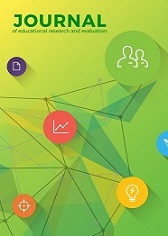DEVELOPING E-LEARNING BY USING KELASE IN BIOLOGY SUBJECT FOR XI GRADE IN SMA NEGERI 1 SEMARAPURA
DOI:
https://doi.org/10.23887/jere.v1i4.12491Kata Kunci:
E-learning, Hannafin & Peck, developmentAbstrak
The problem found at SMA Negeri 1 Semarapura was that the learning achievement in Biology was not yet satisfactory. This study was aimed at (1) describing the design of E-learning development, (2) describing the E-learning design quality validation result according to the expert judges and the product try out result, (3) finding out the effectiveness of E-learning developed. This study was research and development. It used Hannafin and Peck’s model. The data which were collected in this study were qualitative and quantitative data. The data were collected through document recording, questionnaire and test. The results were as follows, (1) the E-learning design for Biology subject using Hannafin and Peck’s model which covered three stages, (2) the E-learning for Biology subject that was developed was valid; (a) the result of content experts’ judgment about the content of the subject shows that the E-learning falls into very good qualification (91.4%), (b) the result of the E-learning experts’ judgment of the E-learning design shows that E-learning falls into good qualification (90.06%), (c) the result of instructional design experts’ judgment about the E-learning falls into good qualification (89.02%), (d) the result of individual try out, small group try out, and field try out show that E-learning falls into good qualification (89.93%), (89.34%), and (83.03%), (3) the effectiveness of the development shows that E-learning that was developed was effective in enhancing Biology learning achievement (tobs. = 25.89 > tc.v. = 2.390, at the 5% level of significance). That means that E-learning has proven to be effective in enhancing Biology learning achievement significantly.
Referensi
Agung, A.A. Gede. 2014. Metodologi Penelitian Pendidikan. Buku Ajar Metodologi Penelitian Pendidikan. Singaraja: Undiksha
Duniawan, I. G. 2014. “Integrasi TIK, E-Learning Solusi Alternatif dalam Kegiatan Pembelajaran”.Makalah disajikan dalam Seminar Problematika Teknologi Pendidikan. Jurusan Teknologi Pendidikan. Singaraja, 22 Desember 2014.
Fithri, D. L. 2014. “Analisa dan Perancangan E-Learning Pembelajaran Grammer untuk Meningkatkan Potensi Siswa”.Jurnal SIMETRIS, Vol 5 No 1 April 2014 ISSN: 2252-4983.
Koyan, I Wayan. 2012. Statistik Pendidikan.Singaraja: Undiksha.
Mahadewi, Luh Putu Putrini. 2013. Pemrograman Dengan Teks. Singaraja: Undiksha
Mahadewi, Luh Putu Putrini.2016. Blended Learning DinamisasiSetingPembelajaran. Singaraja: FIP Undiksha
Mahadewi, Luh Putu Putrini dan I Kadek Edi Yudiana.2016. Pengembangan Prototype PembelajaranOnline Dengan Cognitive Load Theory Pada Mata Kuliah Strategi Pembelajaran di Fakultas Ilmu Pendidikan. (Laporan Penelitian). Singaraja: FIP Undiksha.
Rusman. 2012. Model-model Pembelajaran. Depok: PT Rajagrafindo Persada.
Tegeh, I Made dan I Made Kirna. 2010. Metode Penelitian Pengembangan Pendidikan.Buku Ajar. Singaraja: Undiksha
Unduhan
Diterbitkan
Cara Mengutip
Terbitan
Bagian
Lisensi
Authors who publish with the Journal of Evaluation and Research in Education (JERE) agree to the following terms:
- Authors retain copyright and grant the journal the right of first publication with the work simultaneously licensed under a Creative Commons Attribution License (CC BY-SA 4.0) that allows others to share the work with an acknowledgment of the work's authorship and initial publication in this journal.
- Authors are able to enter into separate, additional contractual arrangements for the non-exclusive distribution of the journal's published version of the work (e.g., post it to an institutional repository or publish it in a book), with an acknowledgment of its initial publication in this journal.
- Authors are permitted and encouraged to post their work online (e.g., in institutional repositories or on their website) prior to and during the submission process, as it can lead to productive exchanges, as well as earlier and greater citation of published work. (See The Effect of Open Access)










